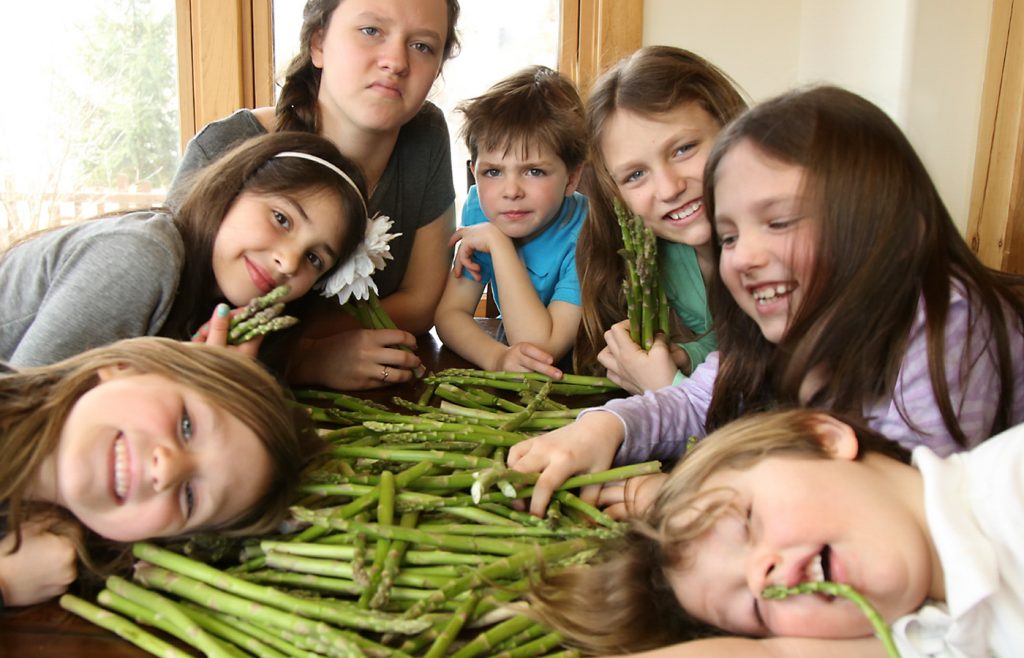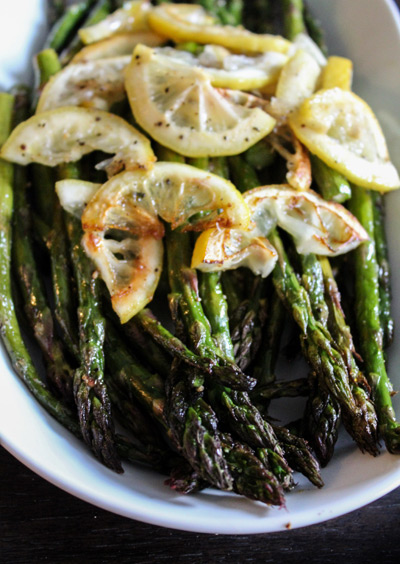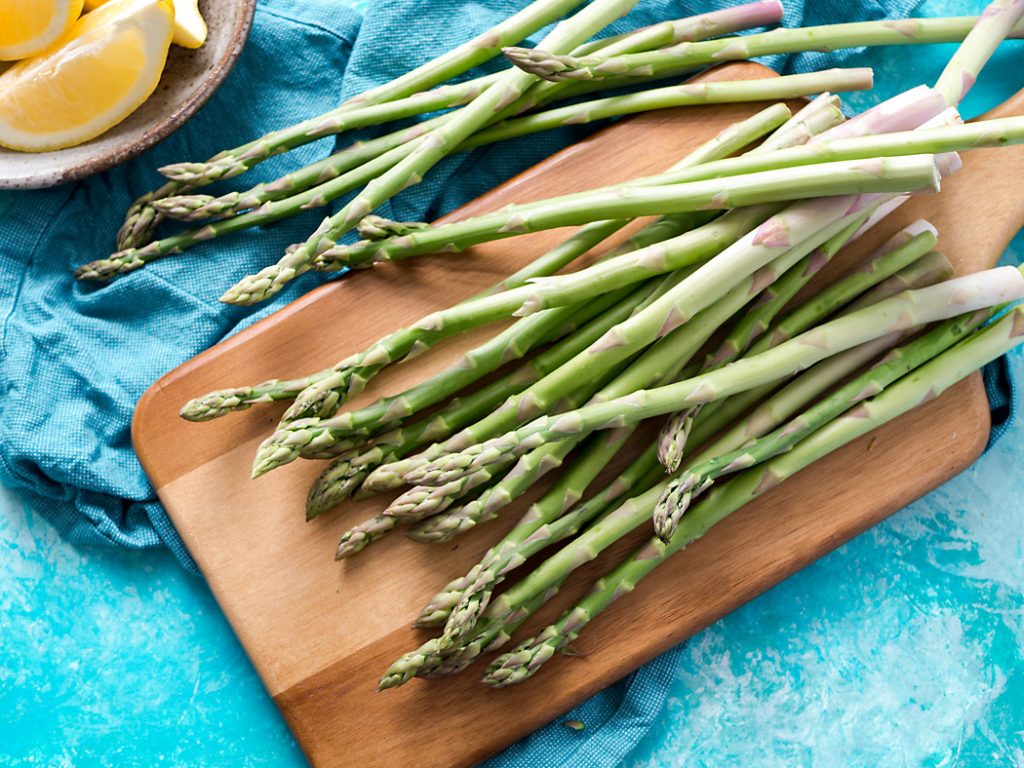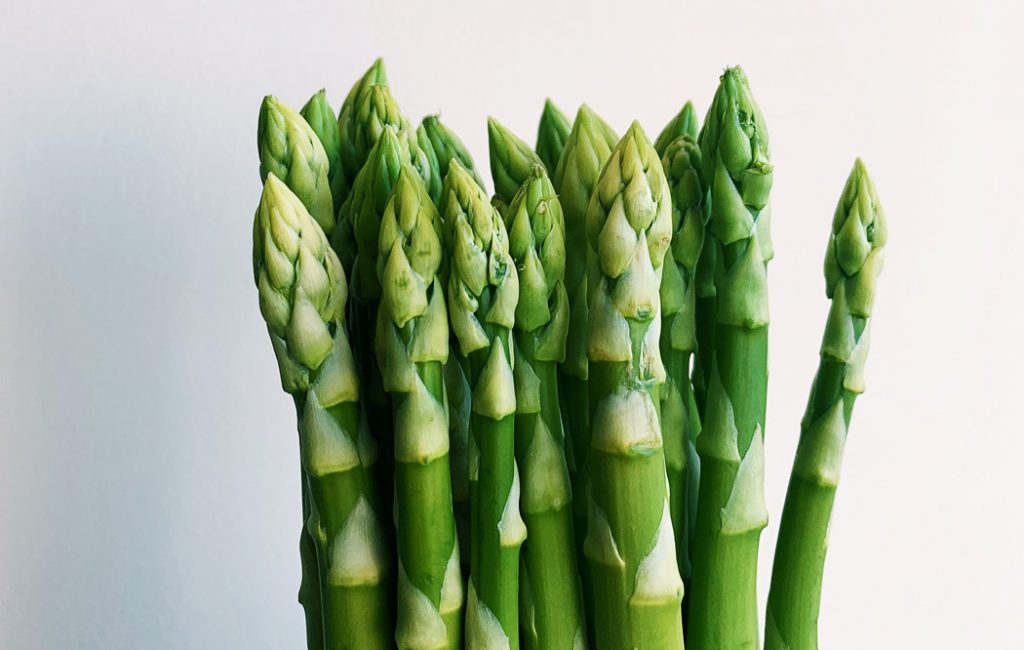
As a kid, I was definitely not allowed to eat “fork food” with my fingers. I figured the same rule applied to every other 12-year-old, so imagine my confusion when I attended a Goldstein family dinner for the first time.
It was Friday night, and I was already a little disoriented from having received a round of hugs, kisses, and “Shabbat Shaloms” from mother Susan, father Marty, and schoolmate Lisa. It’s true, it was my first close encounter with a family who observed the Jewish Sabbath, an unfamiliar tradition, but that night I was also introduced to an unfamiliar vegetable. Asparagus.
It’s not that I wasn’t a good eater—I just didn’t recognize it as food. Asparagus certainly hadn’t been served in the native-Iowa Siemsen household. Lima beans, yes. Peas, corn, and broccoli, absolutely. But what were these rubbery, snake-like green things on my plate? I remembered in the moment that the Goldsteins had relocated from San Diego—maybe it was a California food. Or was it a Jewish dish? I wasn’t about to ask.

I started in with the pasta instead, making sure to keep my elbows off the table as I’d been taught, meanwhile keeping half an eye on my friend, who, as in all things, continued to shock and amaze me. It was easy to be starstruck in Lisa’s presence; she was, by every measure, the smartest kid in my class. I was not expecting such a bizarre display of table manners from someone who was probably a genius.
Lisa lounged against the back of the chair with her bare feet propped up on the front of her seat, knees fully in view. She nonchalantly reached around her protruding legs toward her plate, picked up a floppy piece of asparagus—with her fingers, mind you—and nibbled on it casually while articulating her observations about the one-armed drummer from Def Leppard.
The Goldsteins regularly discussed rock and roll at the dinner table, and in fact, Lisa’s parents had a habit of bursting into song during meals, which I found to be completely adorable and incredibly amusing. But I was still not amused by these stringy-looking things on my plate.
Being the polite kid that I was, I eventually decided to follow Mr. Goldstein’s lead. I cut off a small chunk of the asparagus stalk with my fork . . . and quickly snuck it into my mouth when no one was looking. I hope Lisa’s mom didn’t observe the slight grimace I may have made as I tasted the astringent, earthy, and surprisingly fibrous morsel. And I hope that she didn’t notice the half-eaten vegetable on my plate at the end of the meal. I swear to you, I choked down as much of it as I could. After all, I had received hugs and kisses before the meal. Eating their weird food to the best of my ability was the least I could do to show my appreciation.
They say a kid may have twice as many working taste buds as an adult, which accounts for their extreme sensitivity to certain flavors. I wonder if that could explain my initial rejection of asparagus … because now I love the stuff! Can’t get enough of it. In fact, I’m thinking of starting up my own patch—an endeavor that may initially take some patience, I’m told, but worth the wait.
Your Very Own Patch
To start my research, I reckoned I should talk to Fairfield’s very own “asparagus whisperer,” Michael Havelka, one of the masterminds of the sustainably designed Crow Creek Family Farm just north of town. He assured me he doesn’t actually talk to his asparagus, but with 20-plus years of experience growing the stuff, I was certain he’d be a wealth of knowledge.

“Pretend I’m an idiot and don’t know anything about growing asparagus,” I said. “Where do I start? What should I know?”
“If you don’t do anything else, have well-drained soil. Asparagus is very picky about that,” says Michael, right off the bat. “If it gets wet and stays wet, it’ll get root rot.” Iowa soils, he explains, as good as they are, do tend to be tight and heavy. “The downfall is, they’re not very well drained.” Adding sand, leaves, and organic matter are all great ways to loosen up that soil. Preparing raised beds or mounds is also a particularly good idea for this crop to discourage excess water from hanging around.
“Asparagus likes food,” says Michael, who recommends a healthy diet of aged compost or aged manure. Ideally, add the food to the soil when planting, and give each plant “a side dressing once a year in the spring—a couple of handfuls.”
Instead of starting a patch from seed, save yourself some work and buy asparagus in “crown” form—a gnarly one-year-old root cluster that “looks like some kind of alien octopus,” jokes Michael. He recommends the cultivars that are males, so none of the plant’s energy is going toward making seeds. “You’ll get twice as much asparagus,” he estimates. Male asparagus varieties for the home garden include Jersey Giant, Jersey Knight, Jersey King, and Jersey Supreme. Start planting the crowns when you are able to work the soil, in April or May.
How much asparagus should you start out with? Keep in mind that a healthy plant will give you about 20 shoots over a six-week harvest period. Depending on how much you love asparagus (and how big your family is), maybe try one or two rows of six to ten plants? Plant your crowns at least one foot apart, and space your rows four feet apart, giving yourself a little room to work.
As with most crops, you’ll want to keep the patch as weed-free as possible, so your veggies aren’t competing for space and nutrients. Mulching will also help prevent weed takeover. Michael adds, “In dry weather, water your patch about an inch per week.”
Even though asparagus is a perennial and will produce delicious food for a decade or two, a new patch will take a few years to get established. In the first year, harvesting it is a big no-no. Let it grow. Its fern-like appearance is quite pretty, so just enjoy looking at it for a while—and hope and pray that your neighbor friend continues to share his harvest with you. “The second year,” says Michael, “you can pick at it a little bit, the third year you can do a half harvest” (no longer than a three-week span), “then the fourth year you can just go crazy!”
The longer you wait to really go to town, the more robust—and delicious—your plants will be. So easy there, cowboy.

Your asparagus spears can begin appearing as early as late March, at which point Michael recommends clearing away the mulch to encourage the soil to warm up. Harvest usually starts in April and can last six to eight weeks for mature plants. Michael harvests once a day, in the afternoon, by cutting the spear off right at the base. Be sure to keep an eye on your patch during harvest time, cuz those suckers pop up fast!
“In hot weather they can grow six or eight inches in a day. If you watch, you can actually see ’em grow a little bit,” Michael laughs. Grab them when they’re nice and tender and no more than eight inches tall.
Stop harvesting your patch when the spears become spindly—if they are skinnier than, say, a pencil, it’s time to back off. Let the plant rest and begin storing up energy for the next year.
Asparagus springs into action before almost every other veggie crop. “It’s rather magical,” says Michael. “Everything else is just getting planted and here you are harvesting asparagus.”
Why It’s Good For You
Michael mentions that having asparagus in the diet is “supposed to be good for all kinds of ailments. Ayurveda thinks extremely highly of it, Chinese medicine loves it. I don’t know of any tradition that doesn’t like asparagus.”
Want some specifics? Here’s an impressively long list of health benefits. Asparagus is a low-calorie, high-fiber food, packed with vitamins K, C, E, and A . . . to name a few. It’s a great choice if, like me, you’re wanting to shed a couple pounds. It’s a natural diuretic, which can be helpful in preventing urinary tract infections and flushing out extra fluids and excessive salts. It’s an awesome hangover cure (who knew?). On top of generous amounts of vitamin E, asparagus delivers glutathione, a compound with powerful antioxidant and anticarcinogenic properties, so, yeah, it’s a cancer fighter. Asparagus is a natural source of tryptophan and folate—both of which are mood-lifters—and is also an aphrodisiac, in case you are in need of, ahem, a different kind of lift.
A word to the wise. If you’re experimenting with asparagus for the first time, don’t be freaked out if even after five minutes of consuming the stuff, your urine smells, well, super funky. Nothing is wrong with you. Asparagus contains a unique sulphurous compound called mercaptan that when metabolized gives off a distinctive odor. Your nose may be offended, but the compound causes no harm. Just flush quickly and everything will be fine.
Notably, the folate found in asparagus (also referred to as B9 or, in it’s synthetic form, folic acid) is especially valuable for Moms- and babies-to-be. Folate has been shown to promote adequate birth weight and proper development for your wee baby bundle. Folate has also been linked to the prevention of cognitive brain impairment for adults—yet another anti-aging property. So, I ask, what are you eating for dinner?
From (pre)conception to nursing home, I guess you could say asparagus is recommended for humans of just about any age. Although if you feed it to your Iowa-born, corn-fed kids in their tween years, good luck! You could always smother it with lemon juice, basil-infused olive oil, or even Parmesan. Or maybe just try again after they graduate from college.
